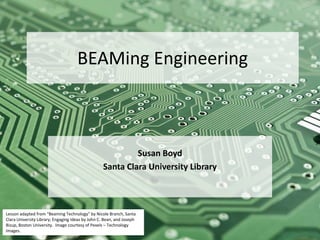Beamengr012219
- 1. BEAMing Engineering Susan Boyd Santa Clara University Library Lesson adapted from âBeaming Technologyâ by Nicole Branch, Santa Clara University Library; Engaging Ideas by John C. Bean, and Joseph Bizup, Boston University. Image courtesy of Pexels â Technology Images.
- 2. Objectives âĒ Plan & execute a search strategy âĒ Evaluate sources for relevance & purpose âĒ Discuss potential value of sources âĒ Select sources for purposes of your assignment
- 3. Ways of Categorizing Sources âĒ Scholarly -------------------------- Popular âĒ Primary --------------------------- Secondary âĒ Good -------------------------------- Bad
- 4. Bizupâs âBEAMâ âĒ Background âĒ Exhibit/Evidence âĒ Argument âĒ Method
- 5. Background âAny source, assumed to be noncontroversial, used to provide contextâĶ facts and informationâ Examples: âĒ Encyclopedia articles âĒ Historical background/facts âĒ Statistics âĒ News anecdotes
- 6. Exhibit/Evidence Sources you analyze or use as evidence. Examples: âĒ Data you collect (experiments, surveys) âĒ Data collected by others âĒ Cultural artifacts you analyze
- 7. Argument âThe conversation of critical views and relevant scholarshipâ related to the topic. Examples: âĒ Scholarly articles about your topic âĒ Scholarly articles about impact of your topic (benefits/drawbacks)
- 8. Method âReferences to the theories or methods the writer is employingâ Examples: âĒ Articles or technical information about particular methodologies âĒ Articles about the argumentative approach you are taking (sociological, economic, etc.)
- 9. BEAM Your Research Topic âĒ Use the mind map to brainstorm topics and sources for each BEAM element
- 10. What can you do with these sources for your writing? âĒGet started finding other information about your topic âĒUsed to explore your argument âĒProvide context for your audienceBackground âĒ Used for the basis of your analysis of your topic and to demonstrate your argument Exhibit âĒ Understand how your topic has been treated by others, including contrasting views âĒ Identify gaps in current understanding of your topic âĒ Justify the argument you are making Argument âĒ Provides information to to help you frame your argument âĒ Can help narrower your argument to a specific area Method
- 13. Where will you find these sources? âĒLook for encyclopedia entries and background information in: âĒReference sources (CREDO, Gale Virtual Reference, Wikipedia) âĒNewspaper & Magazine Databases (New York Times; Ethnic NewsWatch) Background âĒ Look for data, examples and cultural artifacts in: âĒ Your own research âĒ Statistics Sources (Statista, raw data) âĒ Google Exhibit âĒ Look for scholarly articles related to your topic in: âĒ OmniFile âĒ Subject specific databasesArgument âĒ Look for scholarly articles about methods and theories in: âĒ Subject specific databases Method
- 14. Find Sources âĒ Go to the research guide for this class âĒ Using the suggested databases, find sources for your topic âĒ Try to find at least one source for each BEAM element âĒ Complete the form âĒ Send a copy to yourself
Editor's Notes
- #11: http://guides.library.uwm.edu/e102/ebsco What could a writer do with this source? by Kristin M. Woodward/Kate L. Ganski is licensed under a Creative Commons Attribution-NonCommercial-ShareAlike 4.0 International License.















